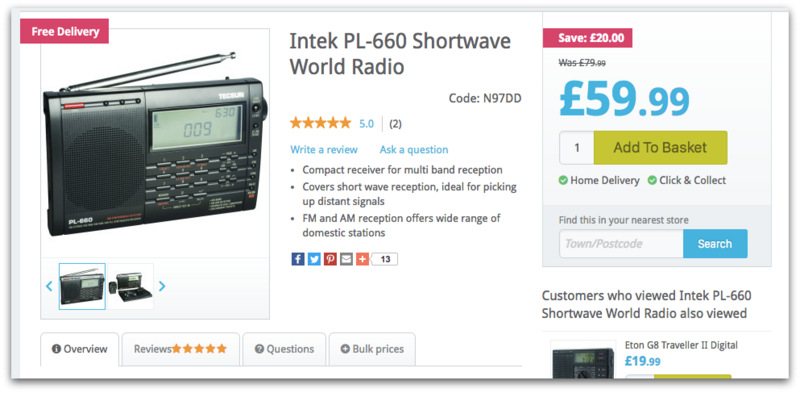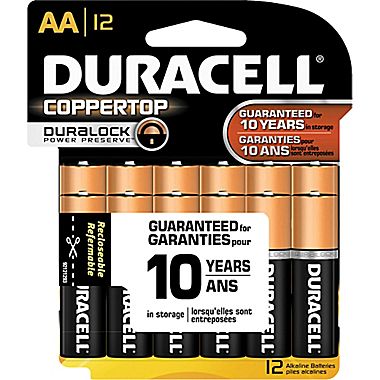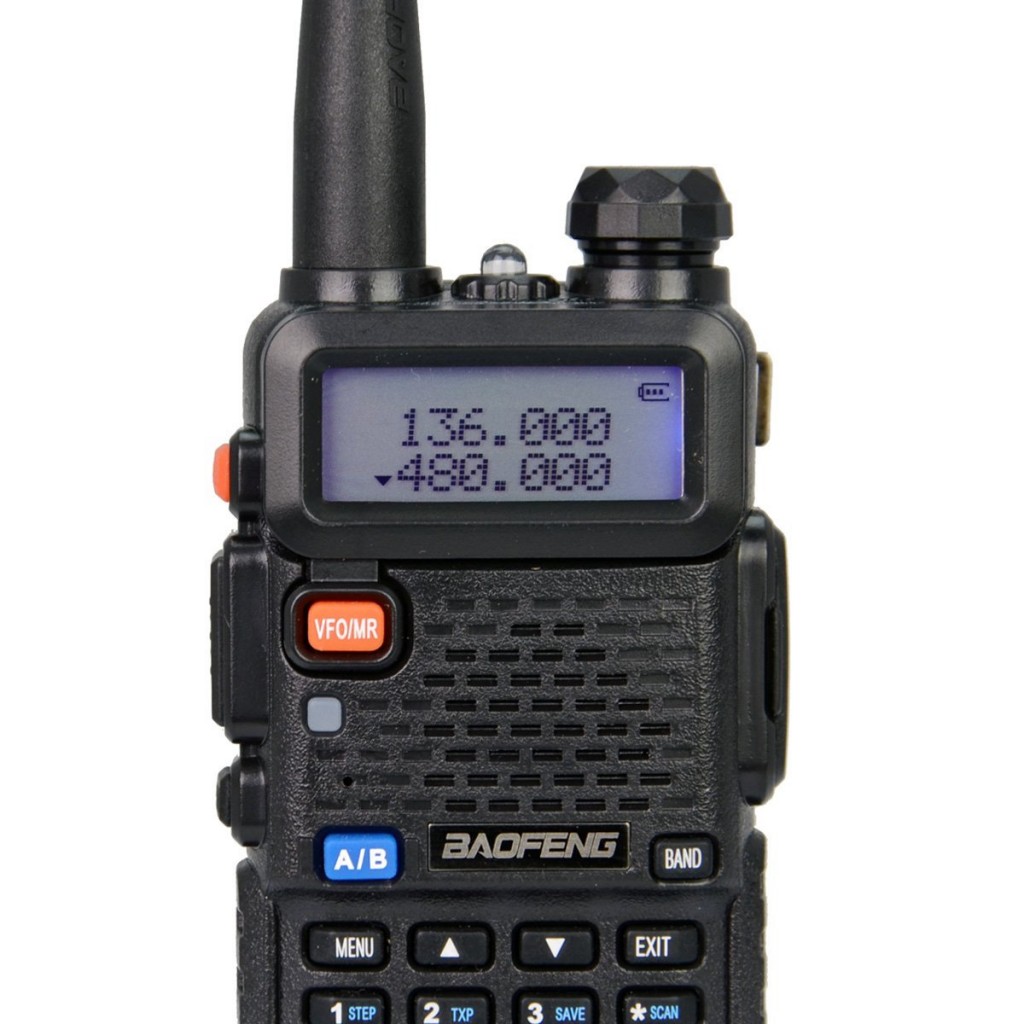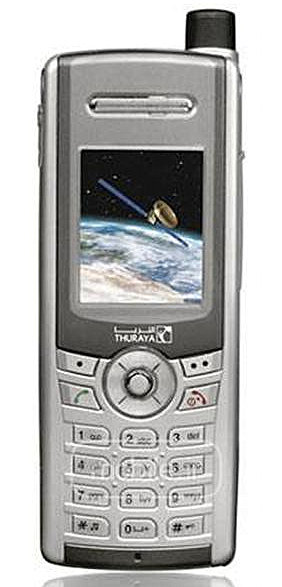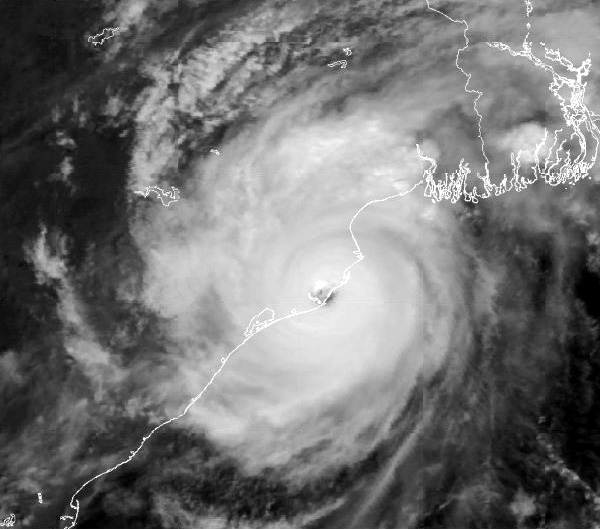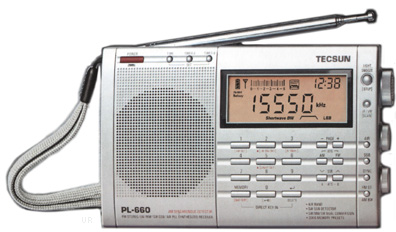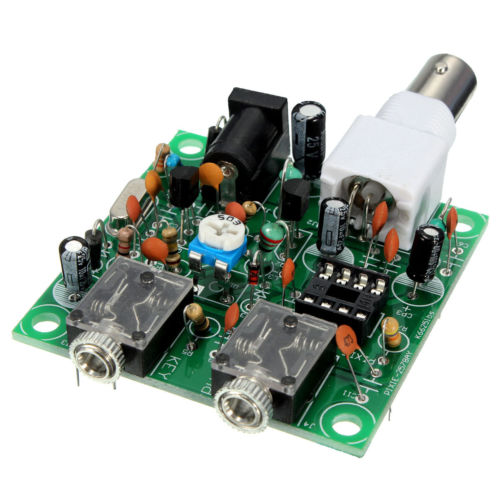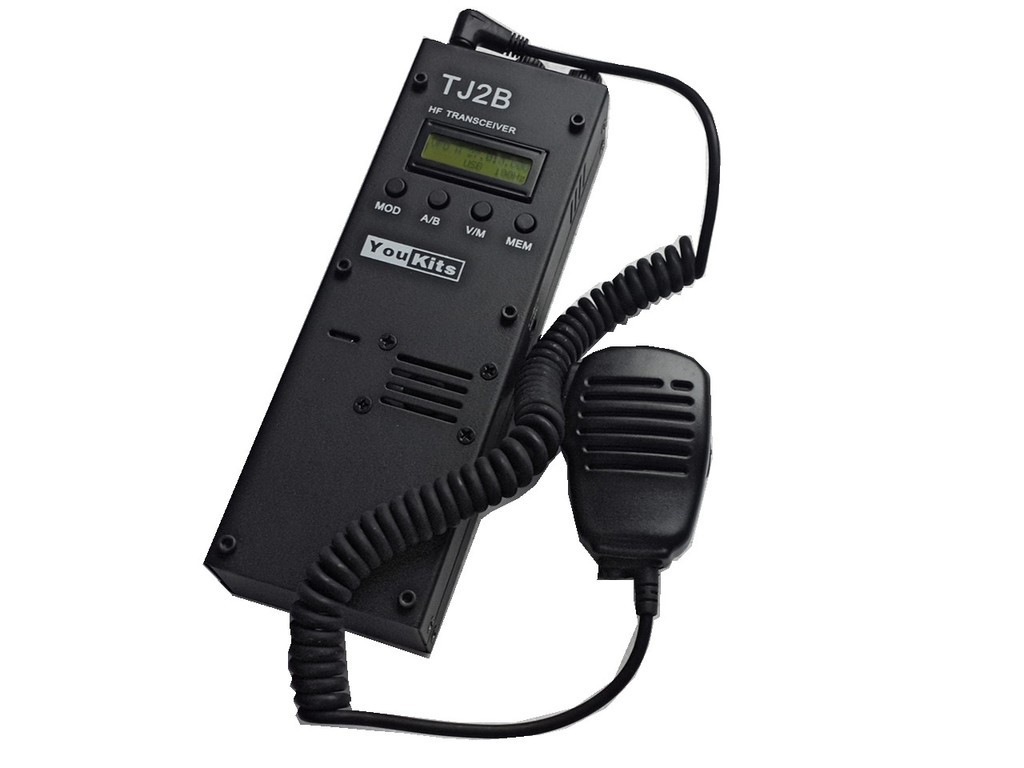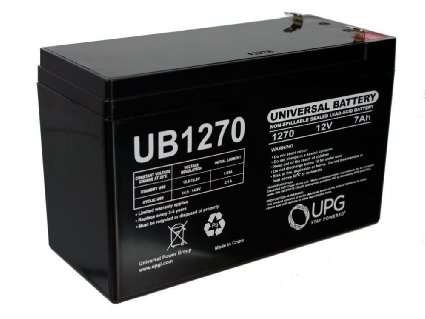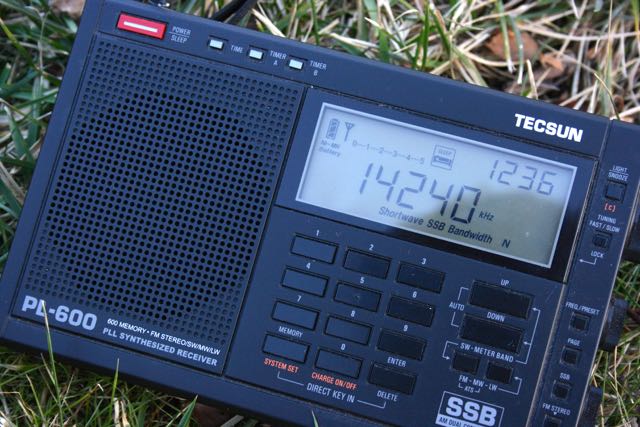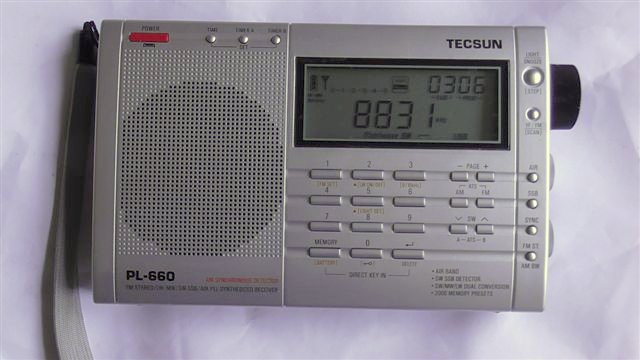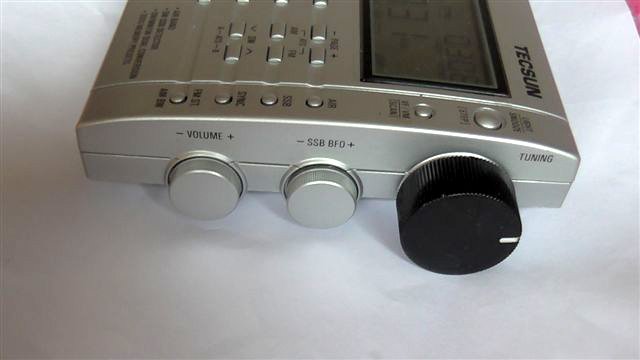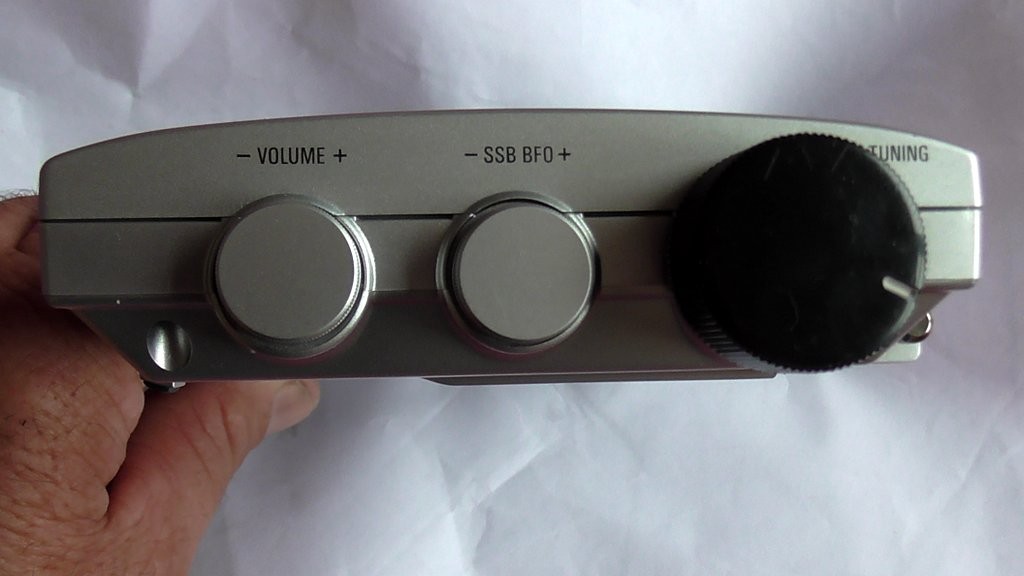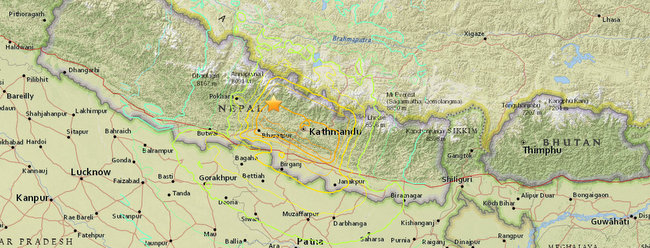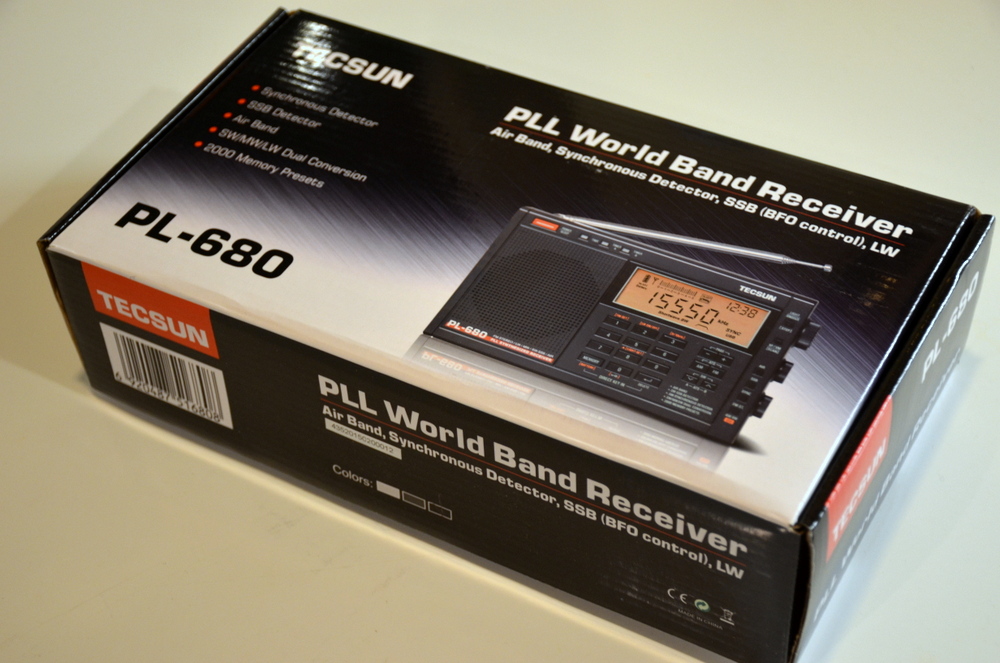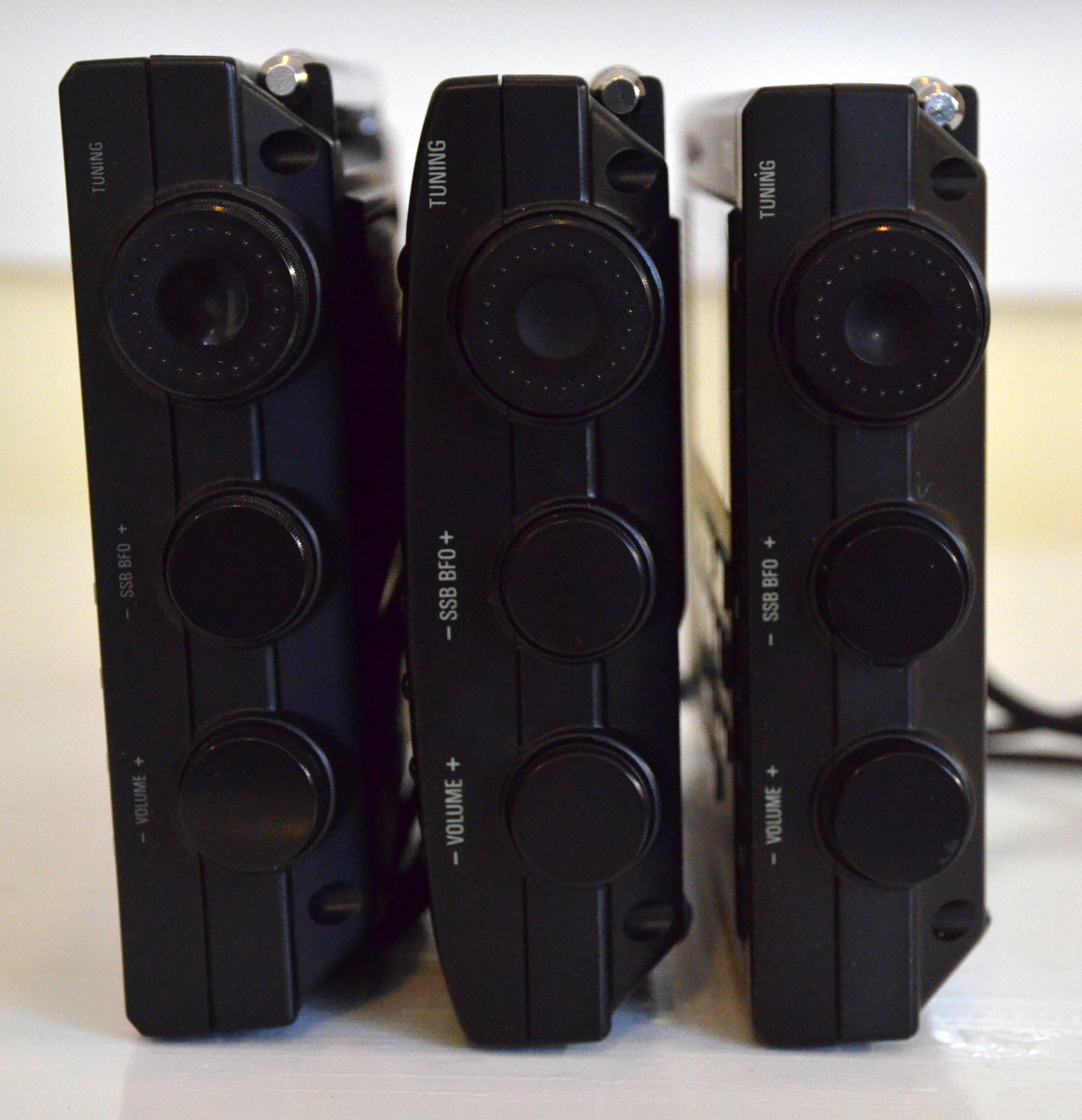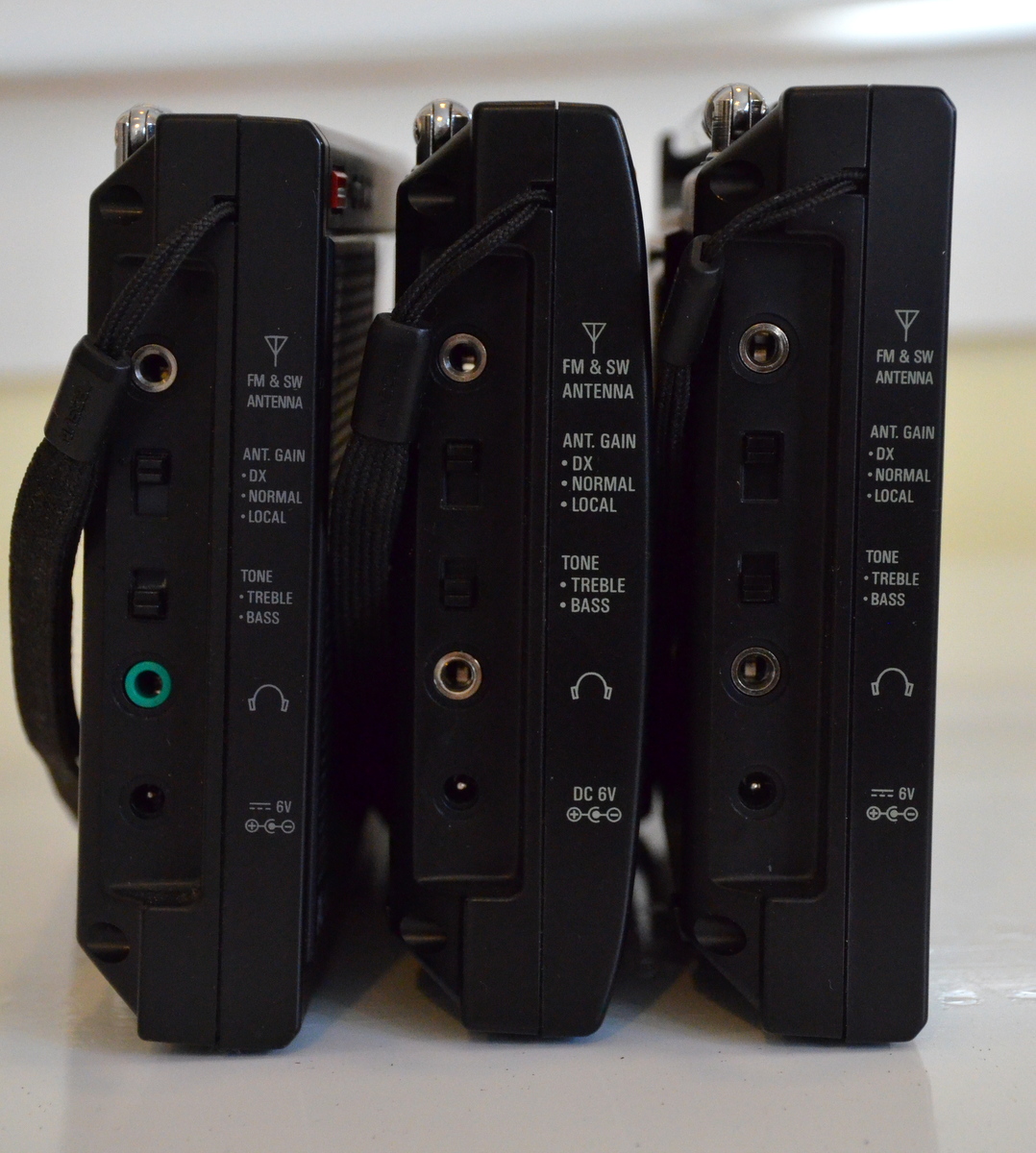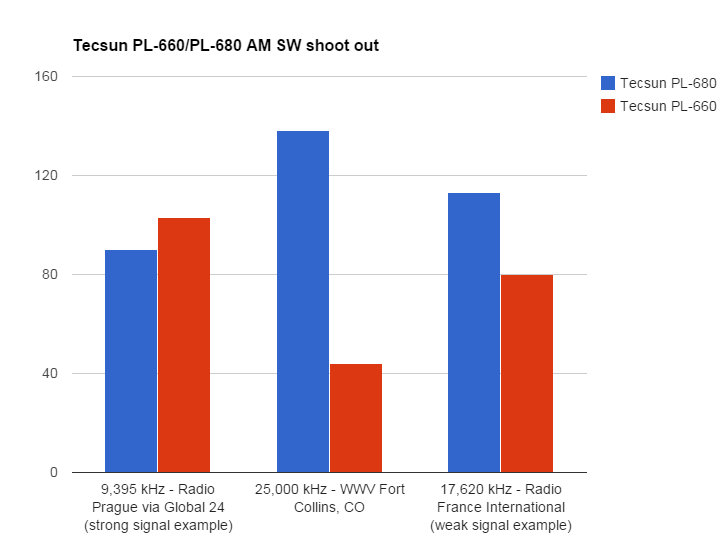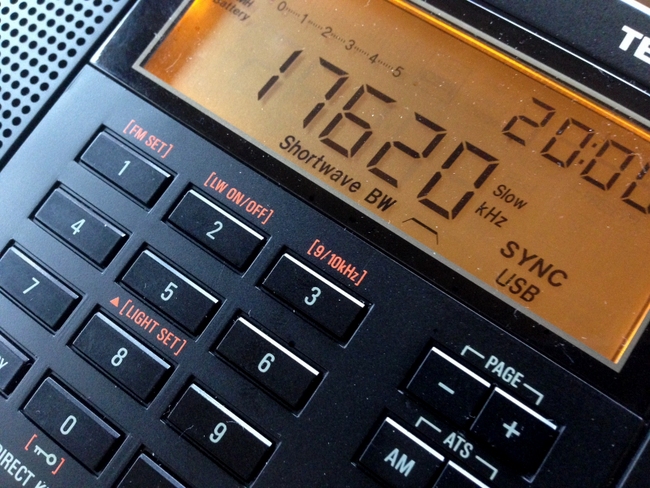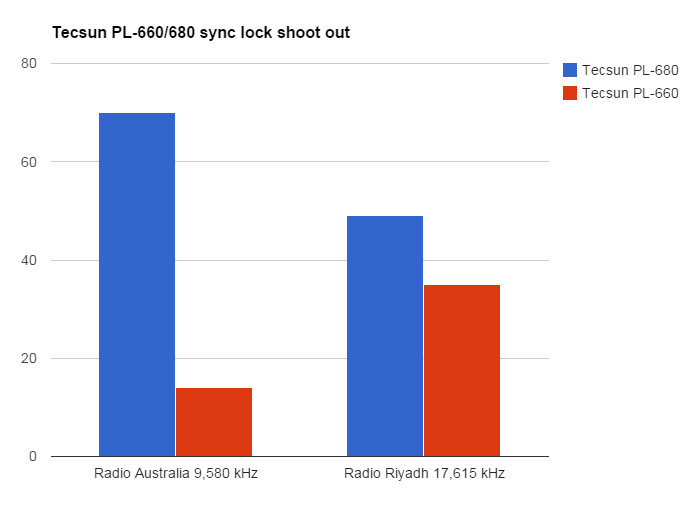If you live in the UK, you might take note that the retailer, Maplin, has the Intek PL-660 on sale for 59.99 GBP. Though I’ve never held an Intek PL-660 in my hands, I’m pretty certain it’s simply a rebadged Tecsun PL-660. (Readers, please correct me if I’m wrong.)
Tag Archives: Tecsun PL-660
Winners of the Virtual Radio Challenge IV: Emergency radio preparedness
Thank you to all of those who entered the Virtual Radio Challenge IV and many thanks to the good folks at CountyComm Government Products Group who volunteered an amazing prize package!

David Cripe (NM0S), our judge for the Emergency Radio Challenge IV, has reviewed all of your challenge entries (click here to read full challenge details).
The following is Dave’s introduction, thoughts on emergency communications and assessment with comments and notes about the winning entries.
Emergency radio communications
David Cripe (NM0S)
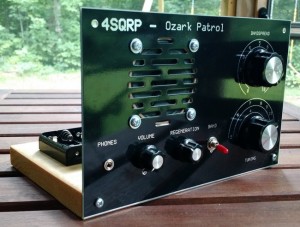
The Ozark Patrol regenerative receiver kit is only one of Dave’s many 4SQRP kit designs.
Greetings to the SWLing Post readers and to those who participated in Radio Challenge IV. When Thomas asked me to judge this contest, I was honored, and eager to help out.
In introduction, I have been a licensed amateur radio operator for 34 years, holding the call NM0S. Thanks to the generous reviews on this blog, many readers may be familiar with my QRP radio kits produced through the Four-State QRP group.
In my home town, I’m know as the guy who does ham radio with the Boy Scouts, setting up and operating a full off-grid campsite field station at ARRL Field Day and the Scouts’ Jamboree On The Air. This has been a great learning experience both for the boys and myself, as a great way to determine what works and does not in less than ideal circumstances. Professionally, I work for a defense contractor, with expertise in military radio systems and their power requirements.
On a personal note, I’ve had first-hand experience with emergency radio communications during the Mississippi River Flood of 1993, Hurricane Isabel in 2003, and the Cedar Rapids Flood of 2008. My evaluation of contest entries were based on these first hand experiences, and lessons learned from published accounts of other natural disasters.
The parameters of the Challenge were drawn from these first hand experiences.
“As is often said, stuff happens. Indeed, our modern communication infrastructure is a fragile thing. Let’s imagine that your area suddenly loses power–as well as cell phone and internet service–for an indeterminate period. Home and personal electronics remain unaffected, but must be powered off-grid (without mains power). Moreover, you may be required to evacuate your home…perhaps even on foot….”
“Therefore, how do you intend to:
- obtain information about local and world events?
- communicate within your local region to assist emergency services?
- pass messages to friends and family over long distances?
- power your kit for an indeterminate amount of time?”
To make the evaluation of the contest entries as fair as possible, I kept off of the SWLing Post blog during the duration of the contest, arranging with K4SWL to send me the compiled entries with identifying information removed.
Equipment
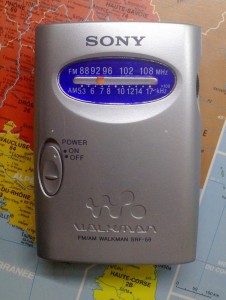
In an emergency or natural disaster, as power and communication infrastructure is damaged or degraded, the main avenue for transmission of information to the populace will be the oldest and most common broadcast medium – AM radio.
Most middle-sized towns have a station, and most families have a battery operated portable receiver. The local new/talk station will become a conduit of information on hazards, evacuations, and requests for assistance. This essential component of the emergency communications kit is the item that most people already have.
There are other sources of information that can provide detail that will not be presented in a radio broadcast. A VHF/UHF scanner pre-programed to local utility frequencies, as well as FRS and GMRS frequencies will let you monitor emergency responder traffic, as well as up-to-date NOAA weather broadcasts.
Those bearing an amateur radio license have the opportunity to not only monitor, but to participate in disaster relief. If two-meter repeaters remain in operation, amateur radio operators have often served to supplant or replace overloaded phone services between hospitals, police, and other first responders.
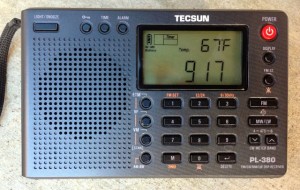 Where the devastation from a disaster is more extensive, or if you are forced to evacuate to a remote location, local communication infrastructure may be completely absent. Shortwave radio broadcasts from around the world can supplement local broadcast media. To handle health and welfare messages from an isolated group, when cell phone reception is absent, long-haul radio capability is required. In many disasters, this has been commonly done using portable HF radio transceivers. When our Boy Scout troop embarks on a high-adventure trip, a satellite phone is packed along. This alternative has the advantage of being able to be used reliably without any skill or licensing.
Where the devastation from a disaster is more extensive, or if you are forced to evacuate to a remote location, local communication infrastructure may be completely absent. Shortwave radio broadcasts from around the world can supplement local broadcast media. To handle health and welfare messages from an isolated group, when cell phone reception is absent, long-haul radio capability is required. In many disasters, this has been commonly done using portable HF radio transceivers. When our Boy Scout troop embarks on a high-adventure trip, a satellite phone is packed along. This alternative has the advantage of being able to be used reliably without any skill or licensing.
Amateur radio
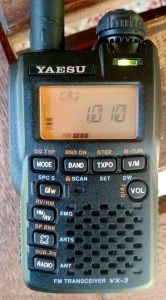 This raises a valuable point: there has been in recent years a surge of interest in amateur radio among those interested in emergency communication and preparedness.
This raises a valuable point: there has been in recent years a surge of interest in amateur radio among those interested in emergency communication and preparedness.
Amateur radio is a powerful tool for communication, and can be an invaluable emergency resource. However, without the user skills acquired through their frequent use before an emergency occurs, the challenge of operating unfamiliar radio equipment in a critical situation greatly reduces their utility.
Without practice in using repeaters, participating in nets, or passing message traffic, the added stress of having to learn these skills under pressure may make a bad situation worse. In short: if you get an amateur license and equipment, use them.
Power
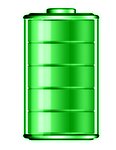 A further requirement is the ability to power the communication equipment. Power-hungry transmitters will burn through batteries quickly.
A further requirement is the ability to power the communication equipment. Power-hungry transmitters will burn through batteries quickly.
The selections available for rechargeable batteries are numerous, but options for charging are somewhat more limited. Thin-film solar panels have recently become an economical power choice for portable operations. Other options, such as hand-crank generators and thermoelectric converters can provide power when sunlight is not available.
Challenge entries
With the Challenge entries in hand, it was a matter of evaluating each versus the stated goals of the Challenge. I was impressed by the documentation accompanying most entries, and justification of choices made.
Nearly every entry specified a portable general-coverage receiver with shortwave and SSB.
The Tecsun PL-660 was a popular choice. Radios of this type are very versatile, reasonably economical, and capable of receiving a wide variety of broadcast signals.
Many of the entries included a BaoFung dual-band HT. This is another excellent choice. Although lacking features found in more expensive HTs, they have the capacity to perform scanning, and can be pressed into service as a FMR or GMRS transceiver in an emergency, The economy of these radios makes their inclusion an obvious choice.
Most entrants showed a great degree of thought in their selection of power sources. Many included solar panels or hand-cranked generators to maintain power over long-term operation.
A minority of entries added equipment capable of long distance two-way conversation. For the most part, these consisted of low-cost fixed-frequency QRP CW transceivers such as the Chinese Pixie or Frogsounds kits. The shortcomings of these kits is having the skills needed for proficient operation–thus limiting their utility–but they are better than nothing.
The Winning Entry: Mehdi
One entry took a different approach to long-distance communication; I consider it the winning entry.
The following was the entry submitted by Mehdi:
Here are my thoughts on how to prepare for the virtual Radio Challenge IV:
I’ve already had this idea on my mind, because I live in a densely populated city (Tehran) and the possibility of an earthquake in near future is not improbable, so the least I could do is to be mentally prepared.
I’ve already bought things like torch, portable radio, and even a real US military compass!!
As for radio kit, first, here’s the list:
1- Tecsun PL-310ET
price: 45$ (free shipping)
link: http://www.aliexpress.com/item/2013-new-style-TECSUN-PL-310ET-FM-AM-MW-SW-LW-DSP-Receiver-WORLD-BAND-Shortwave/861504947.html
2- Pack of 12 AA Duracell batteries
price: 12.70$ (free shipping)
link: http://www.ebay.com/itm/Duracell-Genuine-AA-Size-Alkaline-Battery-12PCS-Retail-Packing-/300811818605?hash=item4609c8166d:m:mTlbVZ55FLboMa6-9csJOpA
3- BaoFeng UV-5R
price: $25.15 (free shipping)
http://www.amazon.com/BaoFeng-UV-5R-Dual-Radio-Black/dp/B007H4VT7A
link: http://www.amazon.com/BaoFeng-UV-5R-Dual-Radio-Black/dp/B007H4VT7A4- BaoFeng spare batteries
price: 15.69 * 2 (free shipping)
link: http://www.amazon.com/gp/product/B00LAPTWE4/ref=s9_al_bw_g422_i2
5- Thuraya SG-2520 satellite phone
price: 76$ (+ 6$ shipping). Used
http://bit.ly/1PRpOdI6- Thuraya SG-2520 heavy duty battery
price: 69.95$ * 2 + 11.86$ shipping (estimated)
link: http://www.satphonecity.com/products/thuraya-heavy-duty-battery-so-2510-sg-2520.html7- Thuraya pre-paid SIM
price: 50$ (free shipping)
link: http://www.amazon.com/gp/product/B00J9O5Y7C/ref=s9_dcbhz_bw_g107_i3_shFirst of all, I chose the Tecsun PL-310ET for this scenario. Why?
I need a light portable radio and it’s got all the functionality I require (AM/FM for local/regional news and SW for international news). I don’t need weather broadcast as we haven’t got that service here. SSB is also not required (found in better models like PL-660). I have also added a 12 pack of AA batteries for it.The third item is a cheap and small VHF/UHF two way radio which lets me listen to local authorities (fire/emergency/…) and other organizations’ radios and also communicate with them in case of emergency. It can also be operated on FRS/GMRS. I’ve also included two spare batteries. (Because the total price of all is above 35$, they’ve got free shipping).
And about Thuraya phone: I chose it because it’s easier to use and smaller/lighter than a portable HF rig. I have also considered portable HF transceivers before, but they have a few problems:
1- Need good power source
2- Propagation affects it (and regarding propagation, we’re not in a very good time now)
3- Not everyone can operate them easily
4- It needs an antenna to be set up
5- A good rig (even a used one) is more expensive than our budget.I’ve also selected two spare batteries for Thuraya plus a SIM card.
The sum of all these items is $397.99 and I’ve considered portability, availability and power selecting these gadgets. I also should stress that I have also considered the compatibility and availability of these gadgets in my own country, so it may not be the best match for US citizens. I’m not sure if Thuraya has US coverage, so it could be replaced by something like Iridium or InmarSat. Also, US citizens may benefit from Weather/NOAA enabled radios.
If I were allowed to spend a little bit more, I would include a solar panel charger (about 20 dollars) too.
It’s just the “radio” related part and I will carry other necessary items in my bag (torch, knives, water, lighters, etc)
P.S. My solution is based on some presumptions, most important of them is leaving house on foot. If I were allowed to spend more and I could bring my car with myself, I probably would select a Yaesu FT-817 which operates on HF/VHF/UHF bands and can be powered from car battery and just needs a car-mounted antenna (It can be replaced with all above items).
Dave’s Analysis:
To a kit containing a BaoFung HT and a Tecsun PL-310, Mehdi added a Thuraya satellite phone. Even though I am a ham radio fanatic with a bias toward HF radio operation, I recognize that the ability to achieve reliable worldwide communication using a device with a minimal operator learning curve gives it a clear advantage for communication in an uncertain environment.
While Mehdi specified a list of battery options for his setup, he was not able include a means of recharging within the $400 budget. He did, though, mention the possibility of adding a low cost solar panel, substituting it for one of the spare battery packs would have been a prudent option.
While Mehdi’s solution is very good, it should be recognized that the satellites employed by the satellite phones do have vulnerability to EMP and CME, as would any other communication method requiring terrestrial infrastructure. I would prefer to see a high-end HF transceiver included as part of the communication package, though this is very challenging within the cost target of the Virtual Radio Challenge. Within that cost constraint though, the satellite phone is an excellent choice.
Runner-up: Ashok
A very close runner up is the entry submitted by Ashok, who in his write-up described his emergency experience during the landfall of a super cyclone in his home of Cuttack, near the Bay of Bengal.
The following was the entry submitted by Ashok:
During October 1999, there was a super cyclone in Bay of Bengal. The land fall of the cyclone was near Paradeep port in the Coastal district of Jagatsinghpur.
Cuttack, my QTH, is about 90km by road and about 70km by air. The intensity of devastation happened in cuttack due to Super Cyclone is frightening. Till date those who have face to face with that have never forget the dreaded situation that day.
In the morning at 9:00 AM wind started and power supply failed within 5 minutes. The only way to get news was through radio.
Unfortunately, we were not aware that such a severe cyclone is on the way, so batteries for radio and flash light were not available. My Father and Uncle were worried and wanted to know what is the situation and precautions we should take. As batteries are not available, I reached out to my “junk box”.
I found a IN34 diode an MW antenna coil a 2j Gang capacitor a old telephone earpiece. Immediately I joined them in to a “Crystal Radio” (no soldering just connected those with hookup wires). I managed to receive Local HPT MW broadcast station AIR Cuttack.
Gradually wind condition and rain got worse with the passing time.
In the evening about 8pm I heard the announcer saying “only GOD can help us survive this cyclone–we wish to speak to all our listeners tomorrow, if we survive” and after that suddenly the transmission is broken and nothing is heard. Later we learned that the transmitting tower was uprooted.
Since then, Odisha has faced major cyclones like Phailin (October, 2013) and Hudhud (October, 2014). Though the devastation is not that widespread but damages are too heavy for a poor state like Odisha.
My Take
Currently I am trying to get a Restricted grade or General grade Ham Radio license. After I get the license I can operate in the HAM bands, but Citizen Band radio doesn’t require a license in India, hence currently I have only one FRS radio (though FRS and CB radios are not popular in my part of India). Still there is a hope that a nearby monitoring station or defense establishment may pick up my signal and may come to rescue.What I propose is as follows.
1) A very good standalone radio receiver (Eg. the Tecsun PL-660). A World band radio can be useful to get news from any available station nearby. The stations in the area hit by cyclone may not have any transmission facility, hence nearby broadcast stations can relay news about the situation.
2) Food
Keep dry foods: Biscuits and sliced breads, 4 liters of drinking waterMy prior experience says one must be prepared for 3 days survival. To survive in a natural calamity like a cyclone, food and water is a must. 2 packs of biscuit and 4 liter of water is enough for only one day. Next 2 to 3 days can be managed after the cyclone recedes by exploring nearby area.
3) Medicines
i) Antiseptic cream 1 small tube
ii) Chlorine tablet for water purification
iii) Paracetamol tablet 1 strip
iv) Anti Diarrhea tablets
v) Anti acid/Gastro regulator tablets
vi) bandages 1 or 2 rolls
vii) clinical alcohol for disinfectionIn emergency situations generic medicines are vital for survival to fight odds. these medicines are for tropical cyclone survival.
4) few matchboxes or cigarette lighter, candle
to light up the shelter in the night candle is needed. to make fire to survive cold matchbox or candle is needed5) A Craftman’s knife
To cut clothes, scale wood for fire.Two-Way Communications:
6) PIXIE like transceiver for SOS use
PIXIE transceivers are easy to construct, very small in size and Low power consuming QRP devices. situations like natural calamities or devastation need smaller devices. it also can be powered from a 9v transistor battery.
7) Hand-held HF SSB Transceiver (DK7IH Handheld QRP SSB Transceiver or TJ2B Portable 4 Band)
Baofeng UV-5R VHF/UHF Transceiver
Voice communication is needed as we can communicate naturally with peers at other end and can convey our feelings easily.Also there is a psychological factor: when we hear a comforting voice we gather our courage and patience.
8) A QRP antenna tuner
Antenna tuners come in handy as we don’t have proper antenna during and after disaster.9) A very long electrical wire. (Twin flexible wires are also good)
Wires are needed for antenna and also can be used for fastening
10) A 12v 7amp hour maintenance-free rechargeable UPS battery.
this is the prime battery for several purposes.
i) Lighting the place with LEDs 4White LEDs plus 1 red LED in series can be connected across 12v
ii) powering the TRX Both DK7IH trx and Pixie11) 9v batteries (quantity of four)
I mentioned 4 batteries as a careful guess work and my previous experience of 1999 cyclone. (We were cut off from the world for 15 days!)With 4 9v transistor batteries and the Pixie QRP transceiver, I can use it in extreme condition.
12) 1.2v NiMH battery packs
These batteries are needed by the DK7IH transceiver, so 1 or 2 sets extra will be nice to have.13) Solar charger for 12v
To charge DK7IH trx batteries. and also for charging the 12v UPS battery. Can be usable after the cyclone recedes. Cloud cover recedes few hours after landfall.14) Hand crank or cycle dynamo. (needed if the situation is extreme and not much sunlight) OPTIONAL…
Prices
- Tecsun PL660 = $85+29 shipping
- Pixie QRP Transceiver = $ 3.59
- Baofeng UV5R = $ 29.99
- 12V 7Ah battery = $ 17.00
- 9V battery x4 = $ 21.68
- 1.2vNiMH(8s pack)x2 = $ 20.70
- Solar charger = $ 17.19
- QRP Antenna Tuner = $ 12.30
- DK7IH Handheld Transceiver = $100.00 (approx)
——————————
TOTAL = $336.45Hand-crank generator = $111.32
Weight Factor:
The most heavy parts are 12V 7Ah battery (2 Kg approx), next heavier thing is solar panel around 1/2 Kg.The Tecsun PL-660 is next 470 grams. So total weight of communication system and power sources combined won’t exceed 5 Kg, Which is comfortable for a back pack.
End Thoughts:
The above prices are for radio communication purpose only. But survival of a cyclone not only depends on communication. It needs a presence of mind and making the right decisions.The DK7IH hand held transceiver is a very compact and nice looking rig. I have it in my wish list I guess it wont exceed more than $100.00.
A hand crank genset is good for situations when sunlight is not available. But it can be considered optional.
I have considered the 12v 7Ah lead acid maintenance free battery from Indian market it costs Rs.850.00 which is $16.00 approximately.
So if we calculate the prices of all the materials then it will cost $336.45. If a hand crank generator is added to this list it will go to $447.77
If I am not taking the hand-crank generator then the remaining money i can go for few meters of wire, some biscuits and water bottles for me and other survivors.
Dave’s Analysis
Ashok’s setup included a Tecsun PL-660, a Baofeng UV-5R, a Pixie, a wire antenna and QRP antenna tuner, and a homebrew 20M SSB transceiver based on the DK7IH design.
Power was provided by 12v, 7AH SLA, and NiMH AAA batteries, recharged by a solar panel. Ashok also had budgeted emergency food and first aid supplies, which while not required in the Challenge, are still an important consideration for emergency preparedness. While the 20M SSB transceiver is not as reliable for long-distance communications as a satellite phone, it does have one important advantage: it is not reliant on satellite infrastructure that would by impacted by EMP or CME.
As I write this, there is a massive relief effort underway in Chennai India as devastating floods affect the region. There are reports of amateur radio operators providing emergency communication to those affected. Lessons learned from this tragedy will help guide us for future emergencies. Exercises like this Radio Challenge help prepare us to face these very kind of situations.
Thank you all for your time and effort.
-Dave Cripe (NM0S)
Thank you!
First of all, I’d like to thank all of those who entered the Virtual Radio Challenge! The Virtual Radio Challenge IV was probably the most demanding of any reader challenges we’ve posted so far.
Congratulations to our winners: Mehdi and Ashtok!
 I would also like to thank CountyComm Government Products Group. Readers should know that Nick, with CountyComm, is a ham radio operator and regular SWLing Post reader. When Nick read about our third radio challenge, he wanted to sponsor our next challenge. Fortunately, I had already started working on a draft of this challenge in the SWLing Post hopper. CountyComm was a perfect fit as a sponsor since much of their product line is used either in tactical situations or for emergency preparedness. Nick went above and beyond the call of duty with his prize package–he has been an enthusiastic supporter. Having a prize makes the whole hypothetical challenge even more fun. Thanks, Nick!
I would also like to thank CountyComm Government Products Group. Readers should know that Nick, with CountyComm, is a ham radio operator and regular SWLing Post reader. When Nick read about our third radio challenge, he wanted to sponsor our next challenge. Fortunately, I had already started working on a draft of this challenge in the SWLing Post hopper. CountyComm was a perfect fit as a sponsor since much of their product line is used either in tactical situations or for emergency preparedness. Nick went above and beyond the call of duty with his prize package–he has been an enthusiastic supporter. Having a prize makes the whole hypothetical challenge even more fun. Thanks, Nick!
Last but not least, I’m very grateful to our judge, David Cripe (NM0S). Dave is a busy guy in both his professional life and in his spare time. When I approached him about being a judge, he knew it would entail hours of research. This was a blind evaluation–Dave only knew entrants by first name or initials. He spent several days worth of his spare time during the Thanksgiving holidays researching product specifications, comparing, evaluating and picking our winners. He is the most knowledgable engineer I know on this particular topic, too. We’re quite fortunate to have him as a resource for this challenge. Thank you so much, Dave!
Early in 2016, I’ll post another–completely different–radio challenge. Like our other challenges, it is based on actual SWLing Post reader questions. I believe it will be a more accessible challenge for those of you who are new to shortwave and ham radio.
Stay tuned!
Which one: The Tecsun PL-660 or the PL-600?
This morning, I received a question I’m often asked. It usually goes something like this:
“Should I purchase the Tecsun PL-600, or invest a little more and purchase the Tecsun PL-660? Is it worth the price difference?”
I decided it best to post this question, along with my response, below.
SWLing Post reader, Warren, writes:
“I have been on your web site for a couple of hours now. I especially appreciated your super review. From that I decided I liked the Tecsun PL-660 best. As I was looking for one on ebay, I saw an ad for a Tecsun PL-600. Although I did find specs on your web site, I did not find a review by you. I did find links to other reviews.
One person said a PL-600 was a PL-660 minus the AIR band.
Another said the SSB didn’t work until he took it apart and replaced a capacitor.
Another said the filters didn’t work as well on the 600, or didn’t exist.
Many said the quality was excellent – buy it! Many said it was terrible.
Can you tell me, in your opinion, which, if any, of the above you agree with? And give me your own rating of the 600?
The 600 is much less expensive than the 660. If it is missing filters and sound quality I’m not interested. If it is only missing the airline band I am very interested.”
Here’s my reply to Warren:
“It is confusing and, you’re right, for some reason I don’t think I’ve ever done my own review of the PL-600–though it’s been included in comparisons.
Here’s my answer to your question:
If you want the best overall performance, go for the Tecsun PL-660. I think it’s well worth the price.
The PL-660 has a great synchronous detector–something the PL-600 lacks–which helps with selective fading and pulling weak signals out of the murk. Since you can select the sideband for the sync lock, you can also use this function to help mitigate adjacent signal interference.
Don’t get me wrong: the Tecsun PL-600 is a great radio in its own right. Of the sub-$100 portables [currently $96 shipped via Amazon, $89.95 plus shipping via Universal Radio], it’s one of my favorites.
The ‘600 is one of the few portables on the market in this price range that has a BFO for single sideband listening (along with the CountyComm GP5/SSB and the Degen DE1103 DSP). When newcomers to the hobby want a full-featured sub-$100 radio that’s simple to operate, I often suggest the PL-600. I’ve never had any issues with my PL-600, by the way–it performed as specified right out of the box and continues to do so today.
But again, if one’s budget allows I always recommend the Tecsun PL-660. In my opinion, the ‘660 offers the best performance and features for the price [currently $109.95 plus shipping at Universal Radio, $119.99 shipped via Amazon].
At home, I believe I actually reach for the PL-660 more often than I do my pricier PL-880.
In a nutshell? Your hunch is right. Get the Tecsun PL-660.”
Readers: Do you agree or disagree? Feel free to comment!
Danny’s Tecsun PL-660 still works after a serious mishap
In response to our Mega Review, Danny Bower comments:
Fantastic review and whilst I know the article is an older one people will still read it when looking at a portable SW radio.
With this in mind I would like to make the following comment about the PL660. You say it is bulletproof and boy is it! Mine has been dropped, kicked and overwise abused and it’s still going strong.
Most remarkably it was knocked into a bucket of water, plugged in and powered up and was there for a good couple of hours fully submerged before I realised.
It wasn’t long good for a week or two but after 3 or 4 weeks I have it one last try before binning it and hey presto it came back to life! Ok the volume pot is now a bit scratchy but other than that it’s working just fine.
Want a radio that will take the general abuse of travelling – this is it…
Wow! Thanks for your comment, Danny! Most impressive that your PL-660 went diving that long and lived to tell the tale. Thanks for sharing!
Simple hack: Changing the tuning knob on the PL-660
Many thanks to SWLing Post contributor, James Patterson, who writes:
Has anyone ever thought of changing the Tuning knob on the PL-660?
Putting a larger knob on it makes for much easier turning instead of the very small fiddly knob Tecsun supply.
Finding the right plastic knob maybe a problem, needing to insert it over the tuner cam. But modifying another knob off something else is what I did.
Tricks of the trade!!
That looks like a very simple and effective mod, making the 660 more tuner-friendly for you! Thank you for sharing, James!
Listening to the Nepal Emergency Amateur Radio Nets
My pal, @K7al_L3afta, recently posted the following recording of the Nepal emergency amateur radio net via Twitter:
He also recorded this short segment relaying that A65DR is alive and well:
@K7al_L3afta is using a PL-660 in an RFI-heavy, urban environment in Morocco. Even knowing some of these operators are using high power, I’m impressed the PL-660 is getting such good reception.
If you have SSB mode on your receiver, you can try monitoring some of the Nepal emergency nets on 14,205 and 14,215 kHz USB.
A review of the Tecsun PL-680 with reader survey results
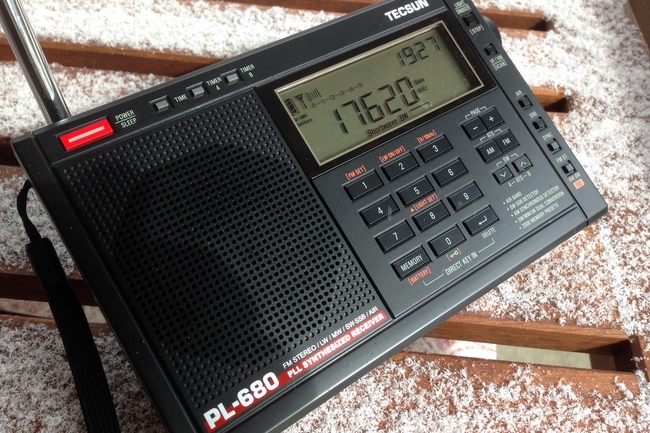 When I heard early reports about the new Tecsun PL-680, I was already wondering how it would stack up alongside other Tecsun portables. An early photo of the Tecsun PL-680 revealed how very similar it is, indeed, to the Tecsun PL-600, which has been on the market for many years. Moreover, the features of PL-680, which I heard about only a few weeks ago, sounded to me like a carbon copy of the venerable PL-660. I investigated further, and spoke with Anna at Anon-Co; she was given to understand that the Tecsun PL-680 was essentially a re-packaged PL-660 with improved sensitivity. I was curious enough about the PL-680 that I ordered one from Anna as soon as they were available, even paying for expedited shipping in order to have it in hand a bit sooner.
When I heard early reports about the new Tecsun PL-680, I was already wondering how it would stack up alongside other Tecsun portables. An early photo of the Tecsun PL-680 revealed how very similar it is, indeed, to the Tecsun PL-600, which has been on the market for many years. Moreover, the features of PL-680, which I heard about only a few weeks ago, sounded to me like a carbon copy of the venerable PL-660. I investigated further, and spoke with Anna at Anon-Co; she was given to understand that the Tecsun PL-680 was essentially a re-packaged PL-660 with improved sensitivity. I was curious enough about the PL-680 that I ordered one from Anna as soon as they were available, even paying for expedited shipping in order to have it in hand a bit sooner.
The Tecsun PL-660 has been on the market for several years now; it’s one of the most popular shortwave portables on the market. And for good reason: the PL-660 is relatively inexpensive, simple to use, packs all of the most vital and desirable functions/modes, and is available from a variety of retailers that ship worldwide. I have reviewed it numerous times and often used it as the basis for comparison with other shortwave portables. It’s China-based manufacturer, Tecsun, has emerged over the past few years as the dominant manufacturer of shortwave radios.
First impressions
I posted a few unboxing photos the day I received the PL-680.
The Tecsun PL-680 looks like the Tecsun PL-600 body, with the Tecsun PL-660 features and layout. Indeed, the full complement of buttons, switches and dials are identically positioned to those of the PL-660.
Let’s cut to the chase…
Question: So, does the PL-680 have more functions than the PL-660?
Answer: No. It appears to be, and likely is, identical in every (functional) respect to the Tecsun PL-660. No surprises here, unless there are hidden features I haven’t discovered…!
Check out the following comparison photos–the PL-600 on the right, PL-660 in the middle, PL-680 on the right (click to enlarge):
The similarity is so striking, in fact, that I believe the PL-680 is the first radio I’ve ever turned on for the first time, only to find I immediately knew every function. I’m so familiar with the PL-660 that I could even use the PL-680 in the dark the first night I used it.
It also helps, of course, that the PL-680 is nearly identical to the PL-600, too, which I’ve owned for many years.
Here’s how I see the PL-680 product development equation:
In truth, I was quite disappointed that Tecsun did not add a line-out jack to the PL-680.
The PL-660, alas, lacks line-out, and though my Tecsun PL-880 has a line-out, its default shortwave volume is simply too high to be used by most digital recorders. I had hoped that the PL-680 might have a proper line-out jack, potentially making it a replacement for my trusty Sony ICF-SW7600GR. Unfortunately, this is not the case.
But other than missing a line-out jack, I really have few complaints. I’ve always been a fan of simple radio design and I believe Tecsun has done a good thing by keeping the user experience so similar in their PL-6XX line of portable shortwave radios. Apparently, a good thing is a good thing.
But here’s what everyone wants to know…
Question: Does the PL-680 have any performance advantages over the PL-660?
Short Answer: Yes! (But keep your PL-660.)
I should add here that I’m about to get rather technical and radio-geeky, so if you’re only interested in a summary, please skip to the bottom of the page.
Otherwise, help yourself to a cup of coffee, and let’s talk radio…
Shortwave performance
Since I spend 95% of my listening time on shortwave, I’ll begin with shortwave performance. Again, we’ll compare the PL-680’s performance with that of the PL-660.
Reader survey results
Having had such great results from radio comparison shoot-outs in the past (check out our shoot-out between top portables and ultra-compact radios), I decided it would make sense to invite our informed readership to evaluate the PL-680’s performance in a series of blind, informal tests. (For information about these surveys, please read through the first of the three surveys.)
Shortwave AM broadcast listening
In most circumstances, you’ll find that the PL-680 has better sensitivity than the PL-660. It’s a marginal improvement, but one I certainly notice on the shortwave bands–and so did the majority of readers who participated in the shortwave AM reception survey.
The survey had recordings from a total of three broadcasters: Radio Prague, WWV, and Radio France International.
The PL-680 was “Radio A,” and the PL-660 was “Radio B.”
The Radio Prague recording was quite strong and was the only broadcast in our survey in which the PL-660 and PL-680 ran neck-and-neck.
In truth, I believe strong signal reception on both these radios is excellent and nearly indistinguishable from each other.
Survey results from the WWV and Radio France International recordings showed a strong preference for the Tecsun PL-680. Again, here are the original recordings:
Based on comments from those who participated, the PL-680 came out ahead of the PL-660 in two respects: better sensitivity, and more stable AGC. In both sets of recordings, the signal was weaker than the Radio Prague recording, and QSB (fading) more pronounced. Herein lies a well-known weakness of the PL-660: soft muting and a sometimes over-active AGC equates to more listening fatigue.
Here is a chart with the full survey results based on 194 listener reports. The number of responses are represented on the vertical axis.
Obviously, the engineers at Tecun addressed the soft muting/AGC problem of the PL-660. In all of my time with the PL-680 on the air, I haven’t noticed any soft muting; the audio has been smooth and the AGC copes with fading much better than the PL-660. No doubt, these two improvements alone make the PL-680 a worthy portable for shortwave radio listening.
There is a downside to the improved sensitivity, however: the PL-680 has a slightly higher noise floor than the PL-660. This is mostly noticeable during weak-signal listening. Though I haven’t compared it yet, I’m willing to bet that the noise floor is comparable to that of the Sony ICF-SW7600GR. Personally, if increased sensitivity and stability means a slightly higher noise floor, I’m okay with that. I find that I listen better when the signal is stable and not fluttering/muting with every QSB trough.
Synchronous detection
The second survey focused on synchronous detection, which is a very useful receiver tool that mitigates adjacent signal interference and improves a signal’s stability. Perhaps it was my good fortune that the same day I tested synchronous detection, fading on even strong stations was pronounced at times. Perfect!
The first recording set was from Radio Australia, a relatively strong signal here in North America. Still, QSB was pronounced–making for an unstable signal–and there was hetrodyne interference in the upper sideband of the broadcast. When I switched the radios into lower sideband sync, halfway through, it effectively mitigated the hetrodyne in all of the recordings.
PL-680 – 1st recording Radio Australia
PL-660 – 1st recording Radio Australia
PL-680 – 2nd recording Radio Australia
PL-660 – 2nd recording Radio Australia
The second set of recordings were of Radio Riyadh–a much weaker station–also affected by QSB:
PL-680 – 1st recording Radio Riyadh (wide band filter)
PL-660 – 1st recording Radio Riyadh (wide band filter)
PL-680 – 2nd recording Radio Riyadh (narrow band filter)
PL-660 – 2nd recording Radio Riyadh (narrow band filter)
While I have always considered the PL-660 to sport one of the stronger sync locks in current production portables, it did truly struggle to maintain a lock in both the Radio Australia and Radio Riyadh recordings. Indeed, I was so surprised by how comparatively feeble the sync lock was on Radio Australia, that I disconnected the PL-660 from the recorder and moved to a different location to verify that something nearby wasn’t causing the sync lock instability. It was not; it was solely due to unstable band conditions.
It came as no surprise that survey respondents took note of the PL-680’s stronger sync lock: the PL-680 beat the PL-660 by a wide margin in both sample recordings. I chart the results, below, from a total of 85 responses:
Very good, PL-680! Someday I’d like to compare the PL-680 with the Sony ICF-SW7600GR, which I’ve always considered to have, among current portables, the strongest sync lock.
Single Sideband
I wasn’t able to provide an audio survey of SSB performance since the PL-680 picked up too much noise from my digital recorder to make for a fair contest.
Meanwhile, I’ve spent time listening to both radios in SSB mode and comparing the models. To my ear, both are very close in SSB performance, but again the PL-680 does have a slight edge on the PL-660 in terms of sensitivity and AGC performance.
SSB audio fidelity is very similar in both radios.
FM Performance
While I haven’t spent more than, let’s say, an hour with the PL-680 on the FM band, I have concluded that it is very sensitive–able to receive all of my benchmark local and regional FM stations.
An informal comparison between thePL-680 and the PL-660 also leads me to believe that they are both excellent FM performers and seemed to compare favorably. I would certainly welcome FM DXers to comment with their own evaluations of the PL-680.
Medium Wave Performance
I’ve also posted a medium-wave listener survey since many of you asked that I provide an evaluation of the medium-wave band.
In short, here is where the PL-680 loses to the PL-660: whereas, on the shortwave bands, the PL-680 is more sensitive, it lacks the same sensitivity on the medium-wave bands.
Though I believe the PL-680 does a marginally better job than the PL-660 of handling the choppy conditions of nighttime MW DX, the PL-660 still pulled voices and music out of the static and made them noticeably more intelligible.
The survey result swung very hard in favor of the PL-660, which has long been one of the more notable medium-wave performers among shortwave portables.
I provided a total of four sample broadcast recordings for comparison. Below, I have embedded one of them–a recording of 940 AM in Macon, Georgia, for your reference.
You can listen to all four recordings in the original survey (again, note that Radio A is the PL-680, B is the PL-660).
Survey results were definitive, with a total of 116 responses:
In all but the strong station sample (750 AM – WBS Atlanta), the PL-660 was preferred by a wide margin.
Summary
Invariably, all radios have strengths and weaknesses; here is a list of my notes from the moment I put the Tecsun PL-680 on the air:
Pros:
- Excellent sensitivity and selectivity on the shortwave bands
- Improved weak signal stability over the PL-660
- Stable sync lock
- Proven PL-600 form factor with good overall ergonomics
- Great internal speaker–an improvement over the PL-660 (but not as good as the PL-880 or Sangean ATS-909X)
- Other than medium-wave performance (see con), a worthy replacement for the PL-660
- Excellent audio from the PL-680 internal speaker (improved over the PL-660, but not matching the fidelity of the PL-880)
Cons:
- Medium-wave performance for is a step backwards from the PL-680’s predecessor, the PL-660. Okay on strong and moderate-signal reception, somewhat poor for weak signals
- Marginal noise floor increase on the shortwave bands
- Like the PL-660, lacks a line-out jack (Please note this, Tecsun!)
- SSB frequency display on my unit is + 1 kHz, slight BFO adjustment is needed (details in this update)
Conclusion
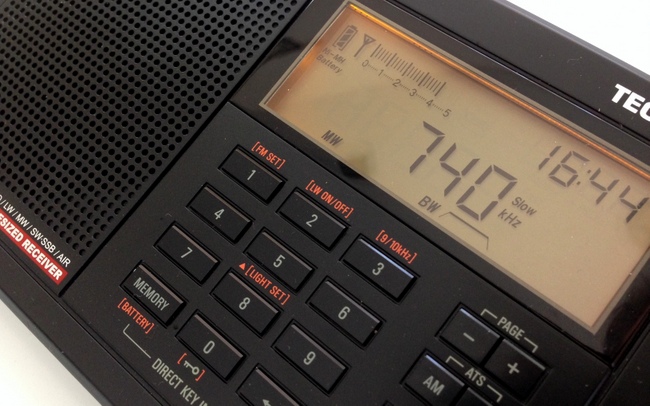 If you’re a shortwave radio listener, you’ll be pleased with the Tecsun PL-680. In all of my comparison tests between the Tecun PL-660 and Tecsun PL-680, the PL-680 tends to edge out the PL-660, performance-wise. This coincides with the user surveys, too.
If you’re a shortwave radio listener, you’ll be pleased with the Tecsun PL-680. In all of my comparison tests between the Tecun PL-660 and Tecsun PL-680, the PL-680 tends to edge out the PL-660, performance-wise. This coincides with the user surveys, too.
If you’re a medium-wave DXer, you might skip over the PL-680. That is, unless Tecsun makes a good iterative design improvement. If you’re a casual medium-wave listener, on the other hand, you’ll probably be pleased with the PL-680.
All in all, I like the Tecsun PL-680 and I see myself using it more than the PL-660 when I’m on the go. If you’re primarily a shortwave radio listener, the PL-680 may very well be worth the upgrade. At $95 US plus shipping, it is certainly a good value. Note that Anon-Co plans to post the Tecsun PL-680 for sale on eBay in March 2015.
Click here to find the PL-680 on eBay.
Addendum:
- PL-680 calibration: Dennis Coomans confirms via Anon-Co that the PL-680 (like the PL-660) can be calibrated by long pressing the AIR button (for SW, AM, etc) and by pressing SYNC for FM. According to Anon-Co, “all PL-680 receivers from production lines after November 2017 have this (hidden) manual calibration feature.”

